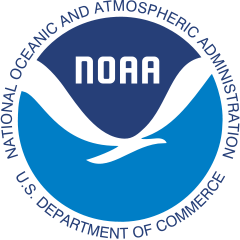The study by Fang et al. [2010] examines the implications of new estimates of the anthropogenic and lightning nitrogen oxide (NOx) sources for the budget of oxidized nitrogen (NOy) over the United States in summer using a 3-D global chemical transport model (MOZART-4). NOy export and burden response less than linearly to either NOx emission changes due to the NOy partitioning change and the corresponding lifetime change. Lightning NOxcontributes 24%−43% of the free tropospheric (FT) NOy export from the U.S. to the North Atlantic and 28%−34% to the NOy wet deposition over the United States. Increasing lightning NOx decreases the fractional contribution of PAN to total NOy export and decreases the FT ozone (O3) production efficiency. Therefore, a model with biased low lightning NOx would lead to biased high downwind O3 responses due to anthropogenic NOx emission regulations. Better constraints on the lightning NOx source are required to more confidently assess the impacts of anthropogenic emission regulations on air quality over downwind regions. Read More…
GFDL Research Highlights
October 1st, 2010 - Sensitivity of polar ozone to sea surface temperatures and halogen amounts
The results of the simulations of Austin and Wilson (2010) suggest the importance of including a coupled ocean on stratospheric processes as well as realistic bromine amounts, including the very short lived species. The figure shows the calculated area of the ozone hole (colored lines and triangles), together with observations (black triangles). With SSTs from the CM2 coupled ocean-atmosphere experiment, the simulated ozone hole (blue) tends to be slightly larger (by about 6%) than simulated with observed SSTs used as forcing (red curve and points). For the low Bromine simulation (green), which corresponds approximately to just the long lived bromine species, the ozone hole was smaller by about 10%. Recent model developments have eliminated the small but significant bias between observations and model results shown in the figure below. Read More…
Multi-variate probability density functions with dynamics (MVD PDFs) have been incorporated into the single-column version of GFDL AM3 and extended to treat aerosol activation. MVD PDFs are unique in that they predict the joint distribution of temperature, water mass, and vertical velocity. The distribution of vertical velocity is then a natural link to aerosol activation. This paper presents the first results on the effects of aerosols and precipitation on cloud fraction and cloud liquid using the MVD PDFs and the first results on cloud droplet number concentrations obtained from the distributions of vertical velocity predicted by the MVD PDFs. Read More…
August 18th, 2010 - Simulations of Underwater Plumes of Dissolved Oil in the Gulf of Mexico
A simple model of the temperature-dependent biological decay of dissolved oil is embedded in an ocean climate model and used to simulate underwater plumes of dissolved and suspended oil originating from a point source in the northern Gulf of Mexico, with an upper-bound supply rate estimated from the contemporary analysis of the Deepwater Horizon blowout. The behavior of plumes at different depths is found to be determined by the combination of sheared current strength and the vertical profile of decay rate. For all plume scenarios, toxic levels of dissolved oil remain confined to the northern Gulf of Mexico, and abate within weeks after the spill stops. An estimate of oxygen consumption due to microbial oxidation of hydrocarbons suggests that a deep plume of hydrocarbons could lead to localized regions of prolonged hypoxia near the source, but only when oxidation of methane is included Read More…
July 2nd, 2010 - Two opposing effects of absorbing aerosols on global-mean precipitation
Absorbing aerosols, such as black carbon, which alter the Earth’s climate by absorbing solar radiation, may suppress precipitation to some extent, a model-supported analysis of the global-mean atmospheric energy budget coauthored by Yi Ming, V. Ramaswamy and Geeta Persad suggests. Read More…
June 17th, 2010 - Observational constraints on the global atmospheric budget of ethanol
Vaishali Naik, Arlene Fiore, Larry Horowitz from GFDL along with co-authors from NASA-AMES, NCAR, NOAA ESRL, University of Minnesota and University of California at Berkeley applied the global chemical-transport model MOZART-4 in conjunction with available observations from several regions around the globe to place constraints on the global budget of atmospheric ethanol. Their analysis indicates that over continental regions, ethanol concentrations predominantly reflect direct anthropogenic and biogenic emission sources. Furthermore, the authors find that current levels of ethanol measured in remote regions are an order of magnitude larger than those in the model, suggesting a major gap in the understanding of the sources and sinks of ethanol. Stronger constraints on the present-day budget and distribution of ethanol and other volatile organic compounds are needed to assess the impacts of increasing the use of ethanol as a fuel. Read More…
May 6th, 2010 - Export of Asian pollution to the western Pacific
Quantifying pollution inflow and outflow over East Asia in spring with regional and global models by Meiyun Lin(Princeton U), Tracey Holloway (U Wisconsin), Greg Carmichael (U Iowa), and Arlene Fiore explores two high-resolution atmospheric chemistry models to examine the role of mesoscale versus synoptic scale processes in controlling pollution export from East Asia. Their results indicate the importance of rapid pollution venting through deep convection that develops along the leading edge of frontal system convergence bands. This transport mechanism is well captured in a high-resolution climate-chemistry model (WRF-Chem), but not adequately resolved in either of two coarse-resolution global models compared with aircraft observations of pollution lofting, suggesting a real need for high-resolution model studies of global pollution transport. Read More…
Identification of anthropogenic and natural dust sources using Moderate Resolution Imaging Spectroradiometer (MODIS) Deep Blue level 2 data by Paul Ginoux (NOAA GFDL), Dmitri Garbuzov (Princeton U) and Christina Hsu (NASA) explores a new method to detect anthropogenic and natural dust sources from satellite data in the eastern part of West Africa. The anthropogenic contribution appears to be significant around the lake Chad, but the magnitude of these sources seem weaker than the natural sources, in particular relative to the Bodele depression. Read More…


